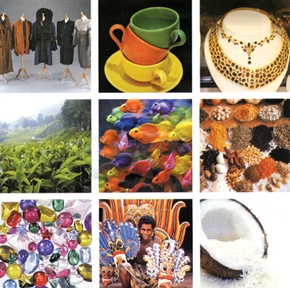Lanka's exports and destinations should be diversified
By Amila Muthukutti
Sri Lanka has been playing a significant part in international trade
since the colonial era.
 As a country blessed with natural resources, the main reason as to
why imperialists came to this tiny island was its export-oriented
natural resources such as spices mainly cinnamon. As a country blessed with natural resources, the main reason as to
why imperialists came to this tiny island was its export-oriented
natural resources such as spices mainly cinnamon.
Since then, such exports have been primary and not value-added. With
the introduction of the open economic policy in 1977, imports began to
play an important role in the economy. However, Sri Lanka imports more
and exports less, resulting in a balance of payment crisis. The country
has been exporting to a limited number of markets such as the Middle
East, USA and the EU.
Sri Lanka has ignored some emerging markets such as Latin America.
Some fluctuations can also be seen in the Sri Lankan export sector, the
majority of which have a bad impact on the economy.
It was recently reported that the European Commission has decided to
impose a ban on fish exports from Sri Lanka to the European Union (EU),
as Sri Lanka had not taken effective measures to tackle illegal fishing.
New markets
This state of affairs is bad, as Sri Lanka is the second largest fish
exporter to the EU. Fish exporters have to find new markets. Not only
comparative advantages but also many more factors such as human rights,
being environment-friendly and adhering to international standards can
influence international trade of any country.
By extension, a country should not always depend on one market, as
the international market is volatile by nature. Sri Lanka's share of
world exports is on the decline.
Apparel and tea exports which claim a large share of Sri Lankan
exports have lost its previous comparative advantages.
The country could attract international businessmen to make
investments in the apparel sector, due to the highly educated and cheap
labour in the country.
That is why, it has been the largest contributor to export earnings.
However, the industry is facing numerous challenges in the competitive
world market. Facilities for workers were upgraded and wages also had to
be increased resulting in higher cost of production.
Girls who were the largest labour force in apparel sector, are
reluctant to join the industry, mainly because of the social stigma
attached to the sector.
Nevertheless, countries such as Bangladesh are ahead of Sri Lanka in
terms of low cost production. The country has lost the previous
comparative advantages it had in the sector.
As Sri Lanka's garments are exported to the USA, the economic
recession in the USA also had a bad impact on the sector.
Challenges
The driving force that has been contributing to export earnings for
decades, has been tea. Although Ceylon Tea has gained wide currency all
over the world, it has been facing challenges in the world market during
the recent past.
The Middle East is the largest market for Sri Lankan tea.
It is important to add some value to tea exports, so that higher
prices could be earned per kilogram of tea.
Packaging tea in tea-bag form results in the highest value per kg.
However, the share of tea-bags as a percentage of total exports
stagnates below 10%. The second highest value per kg is fetched by
instant-tea.
But it accounts for less than 1% of total tea exports.
Emphasis should be made on adding value to tea exports. Kenya is the
most powerful competitor that Sri Lanka faces in the global tea market.
Kenya has so many advantages over Sri Lanka, especially, as Kenyan
lands are flatter compared to Sri Lanka. That will of course assure
higher yields.
Costs
By extension, technology is used at lower level, resulting in low
productivity. Our country has tea estates that were planted and
maintained by the British.
It is needless to state that older estates give a lower harvest. As a
result, the cost of production goes up in comparison to other countries
such as Kenya.
Tea estates suffer from a lack of sufficient labour, as the young
generation is reluctant to join the sector. As the tea industry is
labour intensive, it will have a serious impact on the sector. Sri
Lanka's tea export destinations have chiefly been the Middle East
countries.
However, the possibility of turning the Latin American region into
our tea market should be explored. The time has come for the country to
look beyond traditional export items.
Instead of tea, rubber, coconut and garments, new services such as
education can be exported. Sri Lanka, fully using its peaceful
environment, must create a conducive environment where education
providers and foreign students can meet each other.
Singapore and Malaysia that were behind Sri Lanka, but now export
education as a quality service. Sri Lanka, has always been a labour
intensive country.
However, it seems that the country is losing its comparative
advantages in labour intensive products. Therefore, more FDIs ought to
be attracted to the country, creating a capital intensive environment.
The peaceful environment alone will not attract FDIs.
This is the best time for the country to diversify its exports and
look for new export destinations. The Sri Lankan presence in the global
market should be expanded while retaining traditional markets.
The writer holds a BA in Economics from the University of Colombo |

